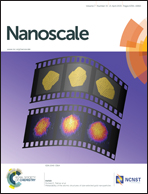New surface radiolabeling schemes of super paramagnetic iron oxide nanoparticles (SPIONs) for biodistribution studies†
Abstract
Nanomaterial based drug delivery systems allow for the independent tuning of the surface chemical and physical properties that affect their biodistribution in vivo and the therapeutic payloads that they are intended to deliver. Additionally, the added therapeutic and diagnostic value of their inherent material properties often provides extra functionality. Iron based nanomaterials with their magnetic properties and easily tailorable surface chemistry are of particular interest as model systems. In this study the core radius of the iron oxide nanoparticles (NPs) was 14.08 ± 3.92 nm while the hydrodynamic radius of the NPs, as determined by Dynamic Light Scattering (DLS), was between 90–110 nm. In this study, different approaches were explored to create radiolabeled NPs that are stable in solution. The NPs were functionalized with polycarboxylate or polyamine surface functional groups. Polycarboxylate functionalized NPs had a zeta potential of −35 mV and polyamine functionalized NPs had a zeta potential of +40 mV. The polycarboxylate functionalized NPs were chosen for in vivo biodistribution studies and hence were radiolabeled with 14C, with a final activity of 0.097 nCi mg−1 of NPs. In chronic studies, the biodistribution profile is tracked using low level radiolabeled proxies of the nanoparticles of interest. Conventionally, these radiolabeled proxies are chemically similar but not chemically identical to the non-radiolabeled NPs of interest. This study is novel as different approaches were explored to create radiolabeled NPs that are stable, possess a hydrodynamic radius of <100 nm and most importantly they exhibit an identical surface chemical functionality as their non-radiolabeled counterparts. Identical chemical functionality of the radiolabeled probes to the non-radiolabeled probes was an important consideration to generate statistically similar biodistribution data sets using multiple imaging and detection techniques. The radiolabeling approach described here is applicable to the synthesis of a large class of nanomaterials with multiple core and surface functionalities. This work combined with the biodistribution data suggests that the radiolabeling schemes carried out in this study have broad implications for use in pharmacokinetic studies for a variety of nanomaterials.


 Please wait while we load your content...
Please wait while we load your content...